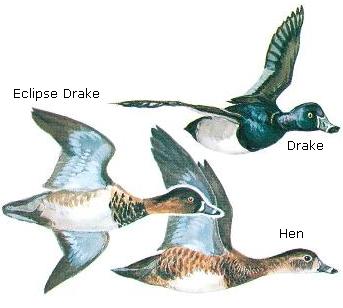Wildlife - Species

Species Specific Regulations
Ring-Necked Duck
Licenses: Hunting License required. Migratory Bird Hunting and Conservation Stamp (Federal Duck Stamp) that is validated by the hunter signing the stamp in ink across the face of the stamp
Limits: Please see Migratory Bird Regulations for any game zones restrictions or Limitations.
Ring-Necked Duck (Aythya collaris)

Description
Ring-necked ducks are similar in appearance to scaups. In flight, the dark wings are different from the white-edged wings of scaup. Faint brown ring on drake’s neck never shows in the field; light bands at tip and base of bill are conspicuous.
Average Size
Ring-necked ducks have an average length of 17 inches and an average weight of 2 1/2 pounds.
Range
While found in all 4 flyways, ring-necks are most common in Central and Mississippi flyways. Ring-necked ducks are winter residents in South Carolina.
Preferred Habitat
In the summer months ring-necks are commonly found in shallow, freshwater wetlands such as marshes, fens, and bogs that have an acidic to near neutral pH. In the winter months they can be found in a variety of freshwater wetlands such as swamps, backwater areas, sloughs, marshes, freshwater impoundments, and flooded agricultural areas.
Typical Flock Pattern

Wings

Food Habits
The diet of the ring-neck is dominated by aquatic plant seeds, tubers, and aquatic invertebrates. During the breeding season they increase their intake of animal foot such as mollusks, snails, and earthworms.
Reproduction
Pair bonds form during spring migration. Nests are built over water in dense emergent vegetation. The female constructs a simple nest bowl of sedges and other plant material. Once the nest is complete the hen lays 6-15 olive buff eggs.
Sound
Drakes purr, and hens are usually silent.
Miscellaneous
- Fly as small flocks in open formation; often land without circling.
- Drake is not territorial, but will defend immediate area around female.
- Found in small flocks during the winter months.
Citations, Publications and Literature
U.S. Fish & Wildlife Service, Federal Duck Stamp Office Presents: North American Waterfowl
Roy, Charlotte L., Christine M. Herwig, William L. Hohman and Robert T. Eberhardt. 2012. Ring-necked Duck (Aythya collaris), The Birds of North America Online (A. Poole, Ed.). Ithaca: Cornell Lab of Ornithology; Retrieved from the Birds of North America Online
South Carolina waterfowl hunters 16 and older are required by state law to obtain a state migratory waterfowl permit and Migratory Game Bird permit. Both permits must be in the hunter's possession while hunting or transporting legal waterfowl. A state waterfowl permit is included with the Lifetime Senior, Lifetime Gratis and Disability Licenses. S.C. residents who hold a Lifetime Senior or Lifetime Gratis License are not required to have a Migratory Game Bird permit.
National Migratory Bird Harvest Information Program (HIP)
The waterfowl permits and HIP permits are available from select DNR offices and from hunting and fishing license agents.